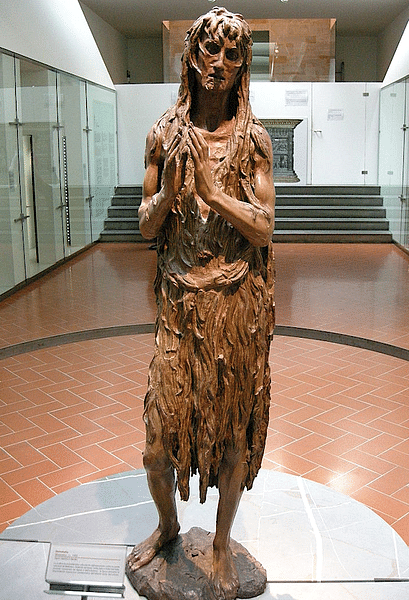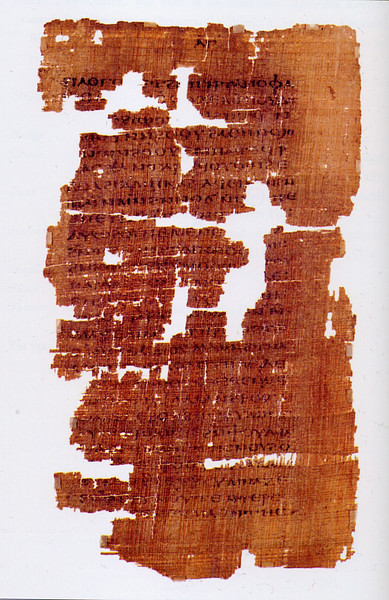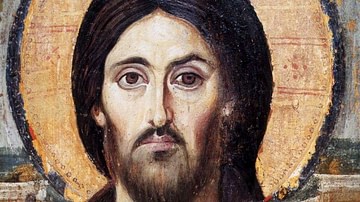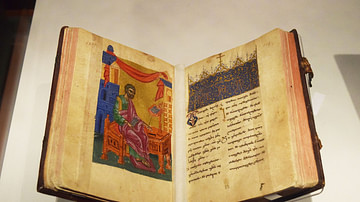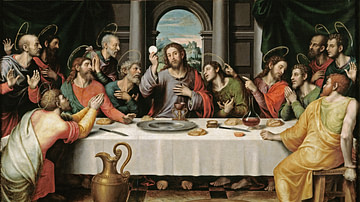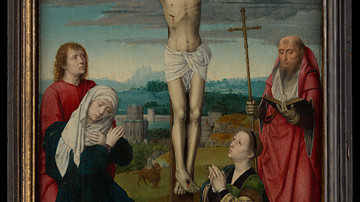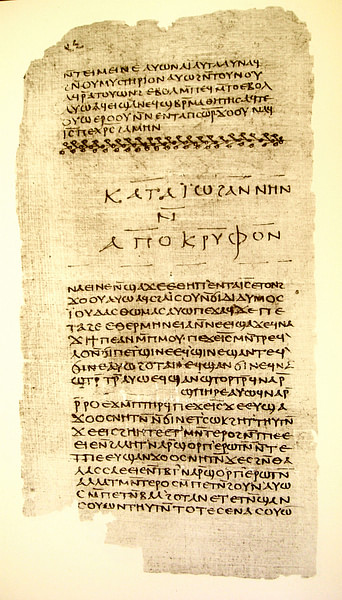
Gnosticism is the belief that human beings contain a piece of God (the highest good or a divine spark) within themselves, which has fallen from the immaterial world into the bodies of humans. All physical matter is subject to decay, rotting, and death. Those bodies and the material world, created by an inferior being, are therefore evil. Trapped in the material world, but ignorant of its status, the pieces of God require knowledge (gnosis) to inform them of their true status. That knowledge must come from outside the material world, and the agent who brings it is the savior or redeemer.
During the first three centuries of Christianity, there was no central authority until after the conversion of Roman emperor Constantine the Great in 312 CE. Christian communities taught many different views. In the 2nd century CE, some groups, now collectively referred to as Gnostic Christians, claimed to have access to 'secret knowledge' about the nature of the universe, the nature of Christ, and what his appearance on earth meant to believers. In the middle of the 2nd century CE, a group of Christian leaders retroactively referred to as the Church Fathers (Justin Martyr, Irenaeus, Tertullian, and others) wrote volumes against these Gnostic Christians.
The Gnostics, as well as the Church Fathers, were educated in the various schools of philosophy. Many of the schools shared the theories of Plato (428/427 - 348/347 BCE) and his view of the universe. For Plato, "god" (or "the highest good") existed beyond the material universe, was perfect, and so would not have created an imperfect world. He posited the existence of a secondary power, the "Demi-Urge," who created matter, the substance of the physical realm. Most Gnostic systems promoted this view.
Gnostic concepts mirror a modern school of philosophy known as existentialism ("how and why do we exist?") Gnostics asked and answered such questions as: "Who am I?" "Where did I come from?" "What is the meaning of life?" "Why am I here?" and "What is my true self?"
Theology
Gnostics promoted concepts of radical dualism that govern the universe. This was polarized as the soul/spark against the flesh, light against darkness. God, who does not create, originally emanated archons (powers), like the light from the sun, seen, but not physical. One of the archons, Sophia ("wisdom"), in a moment of weakness, produced the Demi-Urge, who then created a physical universe, including humans. In philosophical thought, logos ("word") was the principle of rationality that connected the highest god to the material world.
Some systems claimed a mythic "pre-Adam-and-Eve" before their manifestation as humans in the Garden of Eden. In Gnostic understanding, the fall occurred as the result of physical creation. In keeping with the "oneness" of the eternal God, Gnostics promoted the idea of androgyny or the union of gender. After the fall, the logos, the pre-existent Christ, came to earth in human appearance to teach humanity how to return to this original androgyny and reunite with God. According to them, God sent Christ to restore the original cosmos. As the divine spark within humans had fallen asleep, it did not remember its origins. Humans had to be awakened to the presence of this piece of god within them; a concept mirroring Zen Buddhism. When this is accomplished, the rule of archons would end.
The Invention of Orthodoxy/Heresy
The Church Fathers reacted to Gnostic teachings by inventing the twin concepts of orthodoxy and heresy. These concepts did not exist in the ancient world. With the thousands of different native cults in the Mediterranean Basin, there was no central authority that determined what people were to believe. Orthodoxy ("correct belief") and heresy (from the Greek word haeresis, "a school of thought") are two sides of one coin. Heretics are called that by those who disagree with them, but both sides believe they have the correct beliefs.
The Gnostics were condemned as heretics by the Church Fathers for the following reasons:
- The Gnostics promoted a higher God of pure essence and love as the being the true God over the creator God.
- By the 2nd century CE, Christianity was a separate religion from Judaism, but Christians retained the God of Israel and many teachings of the Jewish Scriptures. Gnostics agreed that the creator God in Genesis created the universe, but creation consisted of evil matter. In some Gnostic systems, the God of Israel was not only evil, but Satan himself. Thus, the commandments of the God of Israel were deemed invalid.
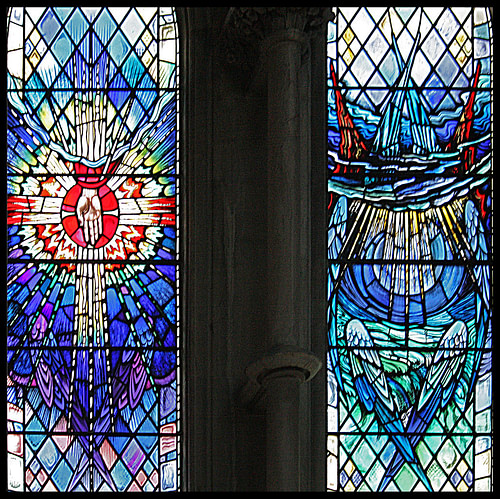 Creation
Creation - Gnostics claimed that their teachings came directly from Jesus. In those scenes in the gospels when Jesus takes the disciples aside to better inform them, he also taught secret things that were passed down to them. The Church Fathers countered this with a claim of apostolic tradition; that their teachings came from Jesus to the original disciples, who passed it to the founding bishops of their communities.
- Consisting of physical matter, the human body was evil. For most Gnostic systems, Jesus was not incarnated into a human body. They preached the concept known as docetic or "appearance." Jesus only appeared in the form of a human so that he could communicate with humanity. If Christ never had a material body, the central pillars of Christianity, the crucifixion and the resurrection of the dead, were nullified.
- A Gnostic, after being awakened, studied the heavens and learned the means to navigate the various layers. In this sense, Gnostics viewed salvation as an individual matter, rather than involving the rest of the community. In other words, salvation could not be achieved through the cross, church hierarchy, or rules.
- Once one successfully made it through the upper atmosphere, one's spark, now home, united with the godhead; in some systems one became God.
- In Gnostic systems, there is a denial of what was becoming standard Christian teaching, eschatology, or the future return of Christ to usher in the kingdom of God. For Gnostics, the kingdom is within the individual.
Gnostic Rituals
Gnostic Christians were baptized, and they participated in the Eucharist (communion). Gnostics did try to promote female ministers in the Eucharistic celebration, bringing them into disagreement with the Church Fathers. The most controversial of Gnostic ritual was "The Bridal Chamber", where one attained "Christhood." In the Gnostic document, Exegesis of the Soul, the language and metaphors of marriage were applied in a union with Christ.
The schools of philosophy taught that one should care for the soul over the body (apathea - "no passions"), not letting the physical urges of the body rule one's life. Such teachings were construed as ascesis ("discipline"), as in athletic disciplining of the body. Gnostic Christians took control of the body literally. They were the first to practice celibacy (not entering into a marriage contract) as well as chastity (never indulging in sexual intercourse). In this way, the traditional life-cycle was broken; no more divine sparks would be trapped in a physical body.
A small minority of Gnostic sects may have taken the opposite view. As part of the evil physical world, governments, man-made laws, and social conventions were no longer valid. Several Church Fathers claimed that this led to sexual immorality. We cannot confirm such practices, but by the 18th century CE, these groups were labeled libertines after the publication of the writings of the French philosopher, the Marquis de Sade (1740-1814 CE). While deploring the Gnostics, nevertheless, the Church Fathers absorbed the concept of celibacy for the clergy. By doing so, it was understood as a living sacrifice (in giving up a normal wife and children). This concept elevated the clergy above the congregation with a sense of holiness.
Like everyone else who was trained in philosophy, Gnostics utilized the literary device of allegory. Allegory is a story, poem, or picture that can be interpreted to reveal a hidden meaning, typically a moral or political one. At the same time, if one is not attuned to the allegorical symbols or meaning, many of the Gnostic writings appear incredibly esoteric and puzzling to the average reader. Reading such texts, one gets the impression that they spent their lives in ivory towers, contemplating the universe. But they did participate in the congregations to which they belonged. They had study groups, but what they studied was the upper reaches of the universe where gradients of powers dwelt. When a Gnostic died, his spark/soul was released from his evil body, but then had to make the journey home. On the way, he/she had to know the passwords to get through and around the powers so that he/she was not distracted. Some systems claimed there were seven heavens, while others claimed 365 levels.
Gnostic Writings - The Nag Hammadi Library
The Church Fathers were voracious in their criticism of Gnostic writings. Scholars, however, were skeptical and could not be sure that the quotations were accurate until 1945 CE. Then two brothers were digging nitrate in the Egyptian desert near the town of Nag Hammadi in Upper Egypt when their shovel hit a large jar filled with codices (early books). They took them to a man they knew who was active in the black-market antiquities business. There were 13 books containing treatises, gospels, and Gnostic myths. They are collected in one volume, The Nag Hammadi Library. As it turns out, the Church Fathers did a fair job of copying. Whereas they utilized quotes, we now have the complete texts for a better analysis of each document.
Gnostic gospels differ from the canonical gospels of the New Testament. They often lack a narrative or a story and consist of simply the teachings of Jesus in elucidating the existence of the true God.
The Gospel of Truth
The Gospel of Truth was thought to be written by Valentinus, a Gnostic teacher from Alexandria who was subsequently excommunicated from Rome (c. 150 CE). One of the most spiritual of the Gnostic gospels, he personified abstractions such as Error, Fear, and Hope as living beings. Christ is described as the manifestation of hope.
The Gospel of Mary Magdalene
This text is incomplete, and the surviving copy begins in the middle. After the death of Jesus, the disciples feel leaderless and dismayed. One of the disciples asks Mary to convey any information she can offer, as it was recognized that Jesus had a special relationship with her. Mary then reveals that she had a post-resurrection revelation from Jesus, who explained many of the Gnostic themes that we have already seen.
The Gospel of Thomas
The Gospel of Thomas is claimed to be written by Jesus’ twin and consists of 114 logia, or sayings of Jesus. The author was familiar with many of the canonical parables and teachings, but the gospel also critiques the traditional concept of Jesus as messiah, promoting Jesus more as an enlightened philosopher. This Jesus says not to look for an earthly kingdom of God; it is found in the turning of the inner person. The Gospel of Thomas has become popular in recent decades in relation to a populist Christian movement known as Liberation Theology, which also teaches self-reflection of each person as the Christ within you. Gustavo Gutierrez coined the term in his 1971 CE book, A Theology of Liberation. He criticized the Catholic Church in Latin America for corrupting the original teachings of Jesus.
As the Nag Hammadi texts became available, many modern feminist theologians admired them for their inclusion of women in their study groups and for their promotion of women eucharistic ministers. At the same time, New Age groups admired what they saw as the elevation of the divine feminine in Sophia. However, the Gnostics were not the equivalent of modern feminists. Each text should be analyzed for its concepts. The Gospel of Thomas ends with:
Simon Peter said to him: "Let Mary go out from our midst, for women are not worthy of life!" Jesus said, "See, I will draw her so as to make her male so that she also may become a living spirit like you males. For every woman who has become male will enter the Kingdom of heaven." 118 [114].
For this system, women will be saved by renouncing their gender, their conventional role as wives and mothers. This was the way for a woman to be restored to the oneness, the concept of androgyny.
The Gospel of Philip
The Gospel of Philip is an example of Gnostic attempts to compromise with the proto-orthodox teachings of the Church Fathers. This gospel promoted the dual form of Christ: Christ was the pre-existent redeemer figure, who possessed the human Jesus of Nazareth for the period of the ministry. Christ entered the man Jesus when the dove landed on Jesus at his baptism. At the time of the crucifixion, Christ left the body so that it was the human Jesus who was crucified. Another Gnostic school in Alexandria led by Basilides (120-140 CE) taught that a bait and switch had occurred at the crucifixion; it was Simon of Cyrene (in the canonical gospels) who was crucified, not Christ.
The Gospel of Philip is also famous for what became infamous in Dan Brown’s The DaVinci Code - the relationship between Jesus and Mary Magdalene. Repeating the scene found in The Gospel of Mary Magdalene, that Jesus had a special relationship with her, we have the line ".... Jesus always greeted you with a kiss on ..." followed by a hole in the manuscript. This line may be significant, or it may simply refer to the fact that the early Christians (including the men) used to greet each other with a kiss on the lips.
The Gospel of Judas
The Gospel of Judas consists of conversations between Jesus and Judas Iscariot. Its rediscovery and translation was published by the National Geographic Society in 2006 CE. Prior to this, it was only known from the 2nd-century CE writings of Bishop Irenaeus, in his Against All Heresies.
In contrast to the canonical gospels, which paint Judas as a betrayer, this gospel claims that Jesus ordered Judas to betray him. The other disciples had not learned the true gospel, which Jesus taught to Judas. Many of the scenes have Jesus and Judas discussing the other eleven disciples, who only perceive reality through the physical senses. They continue to offer animal sacrifices (Jesus mocks the Eucharist as cannibalism), and they believe that martyrdom will save them.
Concepts of Radical Monism
Many of the Gnostic texts challenged the traditional understanding of personhood. In ancient concepts of monism, the person consisted of a physical body and a personality. Both the ancient Persian religion, Zoroastrianism, and well as the schools of Greek philosophy introduced a second substance to a person, the soul (dualism). In most systems, the body and soul worked in harmony. In Gnostic texts, the body and soul oppose each other for dominance. In the more esoteric texts, Gnostics reverted to monism, one being, in that existence was undifferentiated. Going even further, some texts claimed that the material world and existence itself were an illusion. This is where Gnosticism dovetails with ancient concepts found in Hindu and Buddhist philosophy.
Legacy
In 312 CE, Constantine I converted to the Christianity of the Church Fathers. Any dissent from their teachings was deemed heresy, and such texts were ordered to be destroyed. We think this is when someone (perhaps a monk?) buried the texts at Nag Hammadi. Heresy was now viewed as treason. Gnostics essentially went underground, only to reappear in the Middle Ages in the Balkans (the Waldensians) and southern France (the Albigensians). Their teachings were the motivation for the creation of the institution of the Inquisition by the medieval Church in the 12th century CE.
Today we use the term 'agnostic' to describe someone who knows something is out there in relation to the divine but is not sure exactly what. The original word was coined by an 18th-century CE minister, who claimed that he was agnostic, meaning, in its original sense, "not a gnostic - not one of those people." Aldous Huxley (1894-1963 CE) coined agnosticism in his novels on the basis that all knowledge must be based on reason. The psychologist Carl Jung (1875-1961 CE) utilized Gnostic concepts found in medieval alchemy for his theory of archetypes.
Gnostic concepts are now included in science-fiction films, beginning with Ridley Scott’s 1982 CE Blade Runner. It was based upon the short story Do Androids Dream of Electric Sheep? by Philip K. Dick. The plot concerned the creation of perfect androids, who nevertheless began to develop human emotions because of memory implants in their systems. The Wachowski brothers' 1999 CE hit release, The Matrix draws on Gnostic Christianity and Buddhism to pose humanity's fundamental problem and its solution in terms of ignorance and enlightenment. Because of ignorance, people mistake the material world for something real, but they may from this dream with help from a guide who teaches them their true nature.
